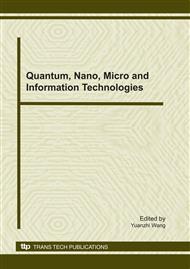[1]
Y.S. Ma, Y.C. Zhang, C.S. Zhang and J.S. Wang: Theory and Approaches to Risk Evaluation of Geological Hazards. Journal of Geomechanics, Vol. 10, No. 1(2004), pp.7-18.
Google Scholar
[2]
S.Q. Wen, R.F. Li and Q.Z. Ren: Application of GIS Technology in the Regionalization of Geological Hazards. Chinese Geology, Vol. 32, No. 3(2005), pp.512-517.
Google Scholar
[3]
X.Y. Fan, J.P. Qiao and Y.B. Chen. Application of Analytic Hierarchy Process in Assessment of Typical Landslide Danger Degree. Journal of Natural Disasters, Vol. 14, No. 1(2004), pp.72-76.
Google Scholar
[4]
S.Y. Liang and X.X. Ma: Comprehensive Assessment of Environmental Impact of Large-scale Water Conservancy Project: a Case Study of Yintao Irrigation Project on Tao River in Gansu, China. The 1st International Conference on Information Science and Engineering, IEEE Computer Society, United States(2009).
DOI: 10.1109/icise.2009.411
Google Scholar
[5]
S.Y. Liang, Y. Wang and Z.Q. Zhou: Geological Hazard Assessment of Small Towns Based on EAHP. International Conference on Management and Service Science, IEEE Computer Society, United States(2009), pp.1-4.
DOI: 10.1109/icmss.2009.5305818
Google Scholar
[6]
Y. Xiong, G.M. Zeng and G.Q. Chen: Combining AHP with GIS in Synthetic Evaluation of Eco-environment Quality: a Case Study of Hunan Province, China, Ecological Modeling, Vol. 209, No. 2-4(2007), pp.97-109.
DOI: 10.1016/j.ecolmodel.2007.06.007
Google Scholar
[7]
Q. Wu, J.J. Fu and M. Yang : Water-power Erosion in mines Coupling GIS, RS and AHP Model. Coal Geology & Exploration, Vol. 32, No. 6(2004), pp.35-38.
Google Scholar
[8]
H.T. Zhang, Y. Zhou and S.Q. Wang. Natural Productivity Evaluation of Cultivated Land Based on GIS and RS Data in Houhu Farm of Jianghan Plain. Transactions of the Chinese Society of Agricultural Engineering, Vol. 19, No. 2(2003), pp.219-222.
Google Scholar
[9]
S.Y. Liang and X.M. Yang: Landslide Hazard Assessment Based on GIS: a Case Study of a Hydropower Station Area in China. 2008 International Workshop on Education Technology and Training and 2008 International Workshop on Geoscience and Remote Sensing, Vol. 1. IEEE Computer Society, United States(2009).
DOI: 10.1109/ettandgrs.2008.104
Google Scholar
[10]
S.Y. Liang, Z.L. Huo and Y.N. Niu: Assessment of Snow Drifting Hazard along Railway: a Case Study of JYH Railway in Xinjiang, China. 2009 International Conference on Environmental Science and Information Application Technology, Vol. 1. IEEE Computer Society, United States(2009).
DOI: 10.1109/esiat.2009.107
Google Scholar


